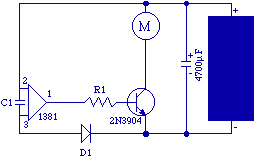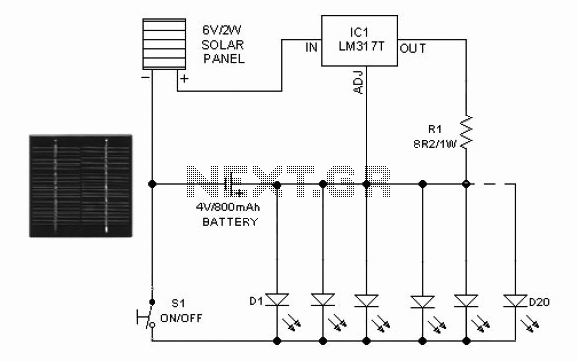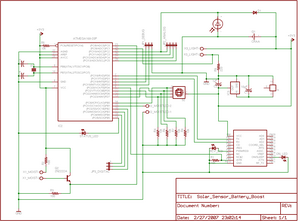
Miller solar engine

The Miller solar engine uses a 1381 voltage detector (a.k.a., a voltage supervisor) IC to drive a voltage-based (type 1) solar engine. The 1381 is normally used to reset CPUs and micros when the power supply drops too low for reliable operation. So 1381s detect and switch when the input voltage crosses the rated upper and lower threshold voltages. The upper- and lower-switching voltages are slightly overlapped so that the turn-on voltage is a few hundred mV above the turn-off voltage.
The Miller solar engine circuit integrates the 1381 voltage detector IC as a critical component for managing power supply stability in solar-powered applications. The 1381 is designed to monitor the voltage levels of a power source, which is essential in scenarios where the power supply can fluctuate, such as in solar energy systems.
The operation of the 1381 involves two key threshold voltages: the upper threshold voltage (V_U) and the lower threshold voltage (V_L). The IC is configured to switch its output state when the input voltage crosses these thresholds. Specifically, when the input voltage rises above V_U, the output transitions to a high state, enabling the solar engine to activate and drive the load. Conversely, if the input voltage falls below V_L, the output switches to a low state, effectively disabling the solar engine to prevent malfunction due to insufficient voltage.
The design ensures that the upper and lower thresholds are closely spaced, which allows for a hysteresis effect. This overlap minimizes the likelihood of rapid toggling between states due to minor voltage fluctuations, thereby enhancing the reliability of the solar engine operation. The hysteresis is typically implemented by selecting specific resistor values in the voltage divider network connected to the 1381, which sets the precise threshold levels.
In practical applications, the Miller solar engine circuit can be employed to power various electronic devices, including microcontrollers, sensors, and other low-power devices. The integration of the 1381 voltage supervisor ensures that these devices operate within their specified voltage ranges, thereby extending their functional lifespan and reliability in solar-powered systems. The circuit can also include additional components such as capacitors for filtering and stabilization, as well as protection diodes to prevent reverse polarity connections, further enhancing the robustness of the design.The Miller solar engine uses a 1381* voltage detector (a.k.a., a voltage supervisor) IC to drive a voltage-based (type 1) solar engine. The 1381 is normally used to reset CPUs and Micros when the power supply drops too low for reliable operation.
So 1381s detect and switch when the input voltage crosses the rated upper and lower threshold voltages. The upper- and lower-switching voltages are slightly overlapped so that the turn-on voltage is a few hundred mV above the turn-off voltage.
🔗 External reference
The Miller solar engine circuit integrates the 1381 voltage detector IC as a critical component for managing power supply stability in solar-powered applications. The 1381 is designed to monitor the voltage levels of a power source, which is essential in scenarios where the power supply can fluctuate, such as in solar energy systems.
The operation of the 1381 involves two key threshold voltages: the upper threshold voltage (V_U) and the lower threshold voltage (V_L). The IC is configured to switch its output state when the input voltage crosses these thresholds. Specifically, when the input voltage rises above V_U, the output transitions to a high state, enabling the solar engine to activate and drive the load. Conversely, if the input voltage falls below V_L, the output switches to a low state, effectively disabling the solar engine to prevent malfunction due to insufficient voltage.
The design ensures that the upper and lower thresholds are closely spaced, which allows for a hysteresis effect. This overlap minimizes the likelihood of rapid toggling between states due to minor voltage fluctuations, thereby enhancing the reliability of the solar engine operation. The hysteresis is typically implemented by selecting specific resistor values in the voltage divider network connected to the 1381, which sets the precise threshold levels.
In practical applications, the Miller solar engine circuit can be employed to power various electronic devices, including microcontrollers, sensors, and other low-power devices. The integration of the 1381 voltage supervisor ensures that these devices operate within their specified voltage ranges, thereby extending their functional lifespan and reliability in solar-powered systems. The circuit can also include additional components such as capacitors for filtering and stabilization, as well as protection diodes to prevent reverse polarity connections, further enhancing the robustness of the design.The Miller solar engine uses a 1381* voltage detector (a.k.a., a voltage supervisor) IC to drive a voltage-based (type 1) solar engine. The 1381 is normally used to reset CPUs and Micros when the power supply drops too low for reliable operation.
So 1381s detect and switch when the input voltage crosses the rated upper and lower threshold voltages. The upper- and lower-switching voltages are slightly overlapped so that the turn-on voltage is a few hundred mV above the turn-off voltage.
🔗 External reference
.png)




